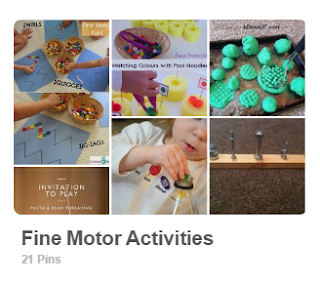Hi everyone, it's Christie from My Mum, the Teacher here, and today I'm going to be sharing with you the reasons I have for making kids with ASD in my classes hand write the majority of their tasks, rather than use their devices to type up work, and why we all need to continue encouraging and developing our children's handwriting skills.
21st Century Literacy and Learning:
Some may argue that in the age of technology we don't need to have such as strong focus on handwriting anymore - writing skills aren't that important since we have so many software programs that automatically edit our grammar, spelling and sentence structure mistakes. But as Kathleen Blake Yancey points out in her paper, "Writing in the 21st Century", we are writing more than we ever have before, both in print and on paper. But as teachers we face the challenge of "developing new models of writing; designing a new curriculum supporting those models; and creating models for teaching that curriculum" (Yancey, 2009) to match the new styles of writing that have emerged.
Many of us grew up in a time when we became literate by reading, writing, speaking and listening. We used phones to speak to another person, and a computer was a very expensive item that was very much a dream for most families!!!!! But children are being born into a world where computers, tablets and smartphones are common place, texts are increasingly multi-modal (that is, they are created using different modes working together), and swiping and typing and learnt before handwriting.
The challenges of teaching handwriting:
Nowadays, many students master writing mid-primary school. However for those with learning difficulties, including those who have high IQ's, handwriting becomes an arduous task because it takes them so long to do - they often draw their letters, unlike neurotypical learners who learn to print them. And while it may seem like handwriting is a relatively minor problem when comparing them to some of their other challenges, it can have an impact upon their learning, even if their functioning at the expected or better-than-expected level.
While most teachers are aware that those on the Spectrum have social and communication issues, there is also a proportion of children who have fine-motor and dexterity issues which pose an issue when it comes to handwriting (It should be noted that not ALL children with ASD have fine motor and handwriting issues - some have wonderful penmanship and artistic skills). While it is often encouraged by parents and external therapists that students use a device such as a tablet or laptop to complete their school work to alleviate some of the anxiety that may come with having students write by hand, this can often be a more frustrating process if students have not had appropriate training and interaction with the device.
Most (NOT ALL) children on the Spectrum often develop a strong liking (some would say addiction) to technology and devices, and enjoy playing games. I've always found it amazing that kids who can whip through games and know every keyboard shortcut and cheat combination can often only type with a single digit, and have no idea of typing keyboard short cuts! I'm working with boys in Year 9, and not one of them is a confident and 'speedy' typer! With this class, and others in the past, I have removed the devices in favour of having the child hand-write their work, with assistance from myself or the teachers aid.
So, how do you ensure you're not making an already anxious child more anxious by asking them to write, but ensure they also improve their handwriting AND typing skills? It's all about balance, and being prepared to challenge them.
1. Set HIGH, but achievable expectations, that are clearly communicated.
We've heard this time and time again, but what does that look like in a classroom?
- Provide clear and easy-to-follow guidelines for book presentation - a ruled margin, lines under headings, a line between paragraphs etc. Even if they are typing their work, have them do this on their device, so that the expectations are the same across the class.
- Have the student write one line, and you (or an aid) write one line. Repeat. This reduces the anxiety of writing the whole text, and allows them to rest but still puts some responsibility on them to complete the task in a timely manner. This method also helps develop strength in the writing hand, and the expectation can be varied as time, and the students' skills, develop.
- Provide students with partial copies of presentation notes - don't make them copy down each and every slide, just the ones that you feel has crucial information that may be retained better if written down. They can stick in the slides, and write the others.
- Give them the notes with missing words/sentences/paragraphs. This means that they need to read and follow the text as its being worked through, but again reduces the amount of writing their expected to do. The same could be done via technology - provide them with the notes through Google Classroom etc. and have them fill in the blanks.
If handwriting is an issue with a child in your class, develop an IEP in conjunction with the family, as well as internal and external agencies, that provides an array of resources and adjustments that will encourage students to develop their skills whilst not raising their anxiety and impacting upon their learning. Don't totally remove the device - but ensure that you set when they can use it, and that it is being used appropriately and effectively.
2. Practice handwriting AND typing skills.
While many of us in today's society are often jumping from one form of technology to the other to write (I'm currently writing this on my computer, and also typing a message to my parents who are travelling through Europe at the moment via my phone), I still like to write by hand. Whether that be in my personal or school diary, or by making shopping lists on note paper. We are also required to fill out forms, write letters and I still plan my netball coaching sessions in a notebook! While technology is hugely present in our society, we are still required to write by hand for certain reasons and occassions - thus, it is important to encourage students, especially those with ASD, to write by hand and learn how to type efficiently so as to be prepared for everyday, independent life.
If you're teaching 5-12 year old's (Primary students), you can incorporate a handwriting and typing activity in your literacy rotations - see some online typing activities below. If you're in high school, you could have one lesson a week during English where students go to a computer lab/library or use their own devices to practice their typing. You could also have them write a essay/argument/story by hand and then have them type it up in a single lesson - giving them a time-frame prepares them for situations such as NAPLAN, tertiary studies and work deadlines.
Typing Games:
BBC Dance Mat Typing - great for ages 5-12.
Typing Games.Zone - great for ages 5-12.
Nitro Typing - 10+
For students with ASD, or any other learning needs that require the use of a device to complete work, set aside time in the week so they can complete typing activities on their devices to ensure they improving their skills and knowledge. Also see if you can have the Learning Support Team set up time to help students complete their tasks.
3. Develop Fine Motor activities.
Incorporating fine motor activities into the learning BEFORE writing starts is a proven way of engaging the muscles and neurons needed for writing. For infants classes, you can make this a part of their morning routine and have a series of activities that children rotate through. For Primary and High School students, you could set up a series of stations in your class, assign students to a station that they go to and work at for the first 5 minutes of the lesson. Check out some of the activities in my Fine Motor Activities board.
I've recently added some fidget cubes to my Year 9 classroom - there are strict rules around these, but along with providing those students who need something in their hand to maintain focus, the various activities on each side of the cube improve their fine motor control. I've also developed something similar to this activity, where students need to recreate the Lego people pictured.
4. Don't stress about the style of their handwriting - focus on autonomy!
Many of my students don't have what I would consider the neatest writing - however they do write! And that's what is important at the moment. And the more they write, the better their writing becomes (generally) as they strengthen their hands, perfect their grip and develop a sense of letter size, shape and spacing.
We all agree that everyone should be able to pick up a pen or pencil and create a note, list or sign on the dotted line, and while the research links fluent handwriting to improved communication skills (both written and verbal), they key isn't the quality, form or style - it's the automaticity of the handwriting. That is, the less a student has to concentrate on getting the letters right, the more brain space they have to devote to ensuring that the message they want to convey is clear and concise.
Just as it is important to develop automaticity for writing, so to is it important to develop this when typing. From 2016, the NAPLAN will be completed online, which means that students will be required to type their compositions rather than hand-write them. Hence my previous point about developing both writing AND typing skills together.
So don't focus so much on standardising your children's handwriting - we all end up with our own style. Instead, focus on encouraging handwriting and typing together to ensure that students are equipped to become functioning members of our society, and
Do you have students who have issues with handwriting in your class? Have you got some strategies that you could share? We'd love to hear from you!
References:
Adoniou, M. (2015). How much does Handwriting matter?
Brownstein, J. (2009). For Intelligent Children With Autism, Handwriting Is Barrier
Mackenzie, N. (2016). Keyboarding, Handwriting or both for 21st century learning?
The Conversation: Supporting students with autism in the classroom: what teachers need to know.



















